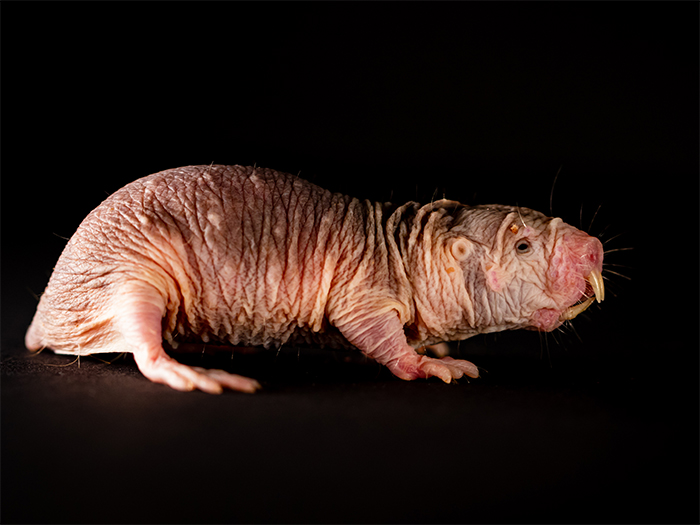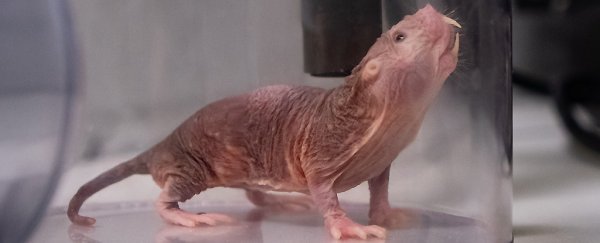We are utterly delighted to welcome the shrivelled skin sacks known as naked mole rats into the elite ranks of animals with confirmed vocal dialects. Their chirps differ based on where they're from - just like we talk with different accents.
"This is an astonishing feat for a rodent and is in stark contrast to the majority of mammalian vocalisations, which are innate, immutable, and genetically inherited," wrote Rochelle Buffenstein for Science Magazine.
Other members of this highly skilled group of vocalists include cetaceans, bats, songbirds and, of course, primates.
But as with everything else regarding these long-lived, pain resistant, kidnapping little weirdos, naked mole rat (Heterocephalus glaber) dialect acquisition is somewhat different, given their strangely insect-like social structure. Their accent is coordinated by their colony's queen.
Naked mole rats are highly cooperative, living in multigenerational colonies of up to 300 individuals. Most of them are sterile workers and soldiers, and they're all under the control of a single breeding queen.
"That is quite an immense task for the queen when you imagine controlling 300 individuals," said neuroscientist Alison Barker from Max-Delbrück Centre for Molecular Medicine (MDC) in Berlin. "So I think having a common dialect really helps with that."
Mole rats are chatty, constantly loudly babbling with at least 17 distinct versions of peeps, chirrups and grunts. Their most common call is a soft chirp which they use as a greeting. It is what the researchers describe as antiphonal - meaning the call invites a response.

Barker and colleagues analysed over 36,000 calls from 166 animals across seven colonies housed in Germany and South Africa. The team then trained an algorithm to learn patterns of chirps, leading it to reliably identify individuals within any single colony from its calls alone.
Playing the calls back to individual mole rats, the researchers witnessed much higher response rates to calls from their own colony than those from others - demonstrating the uniqueness of each colony's call behaviourally.
The researchers found no distinguishing features about the calls to indicate rank, age or sex of the naked mole rat, but their pitch seemed to depend on body size.
Barker and team then fostered pups between colonies to see if the specific call is maintained across generations. The pups developed adult calls by three months of age and successfully adopted the calls of their current colony.
During the two years of their study, one of the colonies lost two queens. This allowed the researchers to record the colony calls' changes during its transition between rulers.
"We show when the queen is lost, the colony dialect disintegrates, so it seems that she's important for not only maintaining control of the colony but also maintaining some of the cues that are needed to maintain colony membership," explained Barker.
When a new ruler ascended in the colony, her subjects soon adapted to her version of the greeting call. This shows that even as adults, mole rats are capable of learning new versions of calls - demonstrating that their language is cultural, not genetic.
 Each naked mole rat has its own distinctive voice. (Felix Petermann/MDC)
Each naked mole rat has its own distinctive voice. (Felix Petermann/MDC)
These naked burrowers are extremely territorial and their greeting call-and-response system would allow them to instantly recognise invaders, whom they won't hesitate to attack and kill.
Yet, regardless of which colony the calls came from, when given a choice, an individual prefers a room where they can hear others to being alone.
This is the first example of communicating social information through sound in rodents - creatures quite different from other animals known to do this.
Such a suggestion of convergent evolution (where evolution finds the same solution to a problem across species not directly related) adds to growing evidence that complex vocalisations are highly interlinked with social complexity.
"This is a whole new order of animals that shows a vocal culture," said neuroscientist Gary Lewin from MDC, explaining the brains of mole rats are very similar to those of well-studied mouse brains.
Yet something different is allowing the naked mole rats to take their socialisation to a different level. He's keen to work out the physiology behind this special something.
"We believe that if we can figure out what makes a social brain in a mole rat then this will give us very deep insights into what makes humans social," said Lewin.
And wouldn't it be neat if unravelling the biological mechanisms behind this might one day allow us to better understand other social species, too?
This research was published in Science.
